NURS3002 Nursing Assignment: Decision-Making in Practice
VerifiedAdded on 2023/06/04
|12
|3394
|304
Report
AI Summary
This nursing assignment report delves into two key decision-making theories: information processing theory and intuitive theory, analyzing their core features, development in nurses, strengths, and limitations. The report then applies these theories to a case study involving a five-year-old patient with tonsillitis, detailing the patient's condition, identified issues (fever, sore throat/cough, decreased oral intake), and the nursing interventions implemented. The report highlights the clinical reasoning process, including cue acquisition, clustering, interpretation, and the application of information processing theory to assess and manage the patient's condition. The interventions included managing the patient's symptoms by preventing aspiration, relieving pain, encouraging fluid intake, and providing family teaching. The report also considers the use of clinical judgment and the importance of family involvement in patient care. The assignment demonstrates the practical application of decision-making theories in a real-world nursing scenario, emphasizing the importance of structured decision-making and clinical reasoning in patient care.
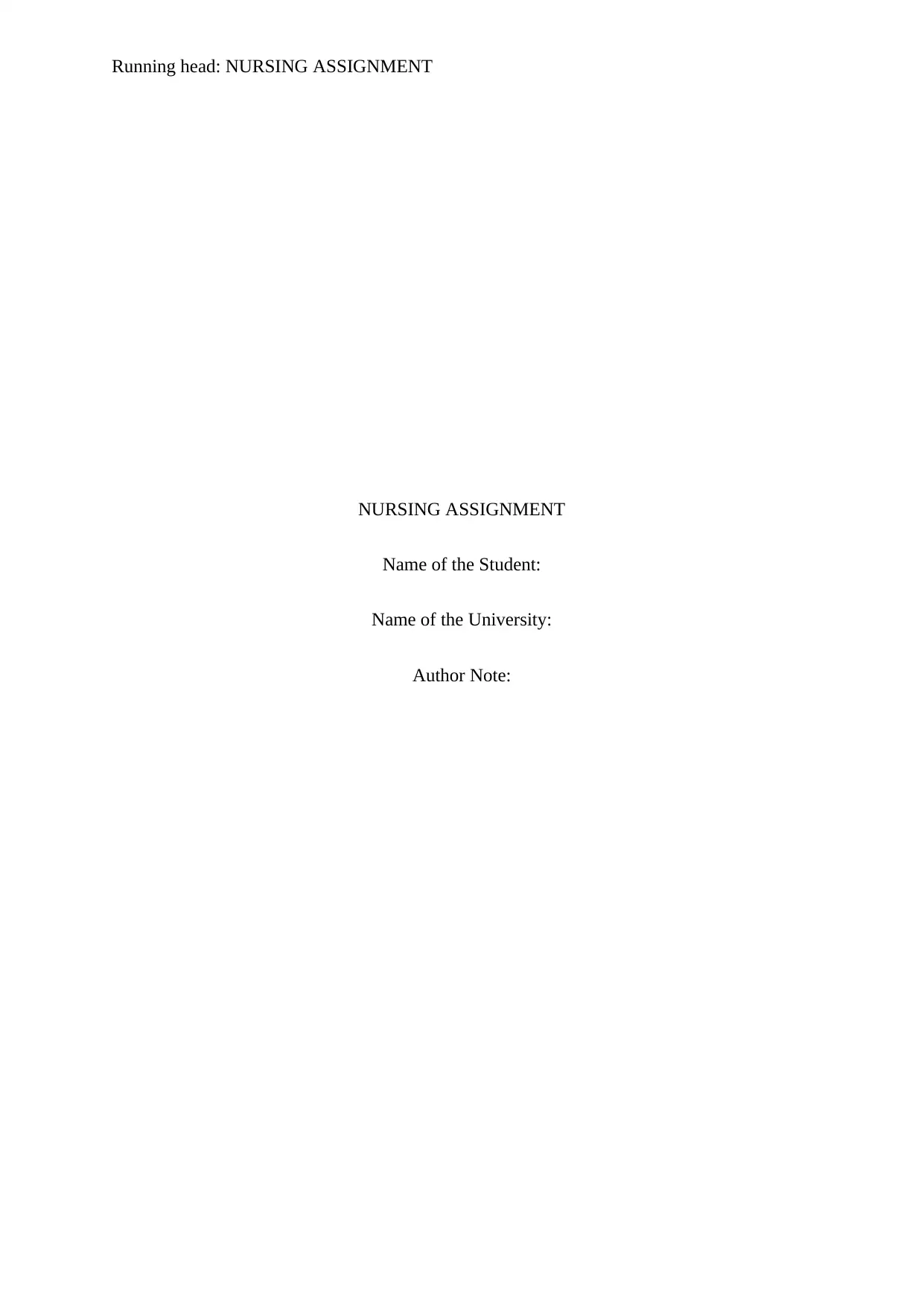
Running head: NURSING ASSIGNMENT
NURSING ASSIGNMENT
Name of the Student:
Name of the University:
Author Note:
NURSING ASSIGNMENT
Name of the Student:
Name of the University:
Author Note:
Paraphrase This Document
Need a fresh take? Get an instant paraphrase of this document with our AI Paraphraser
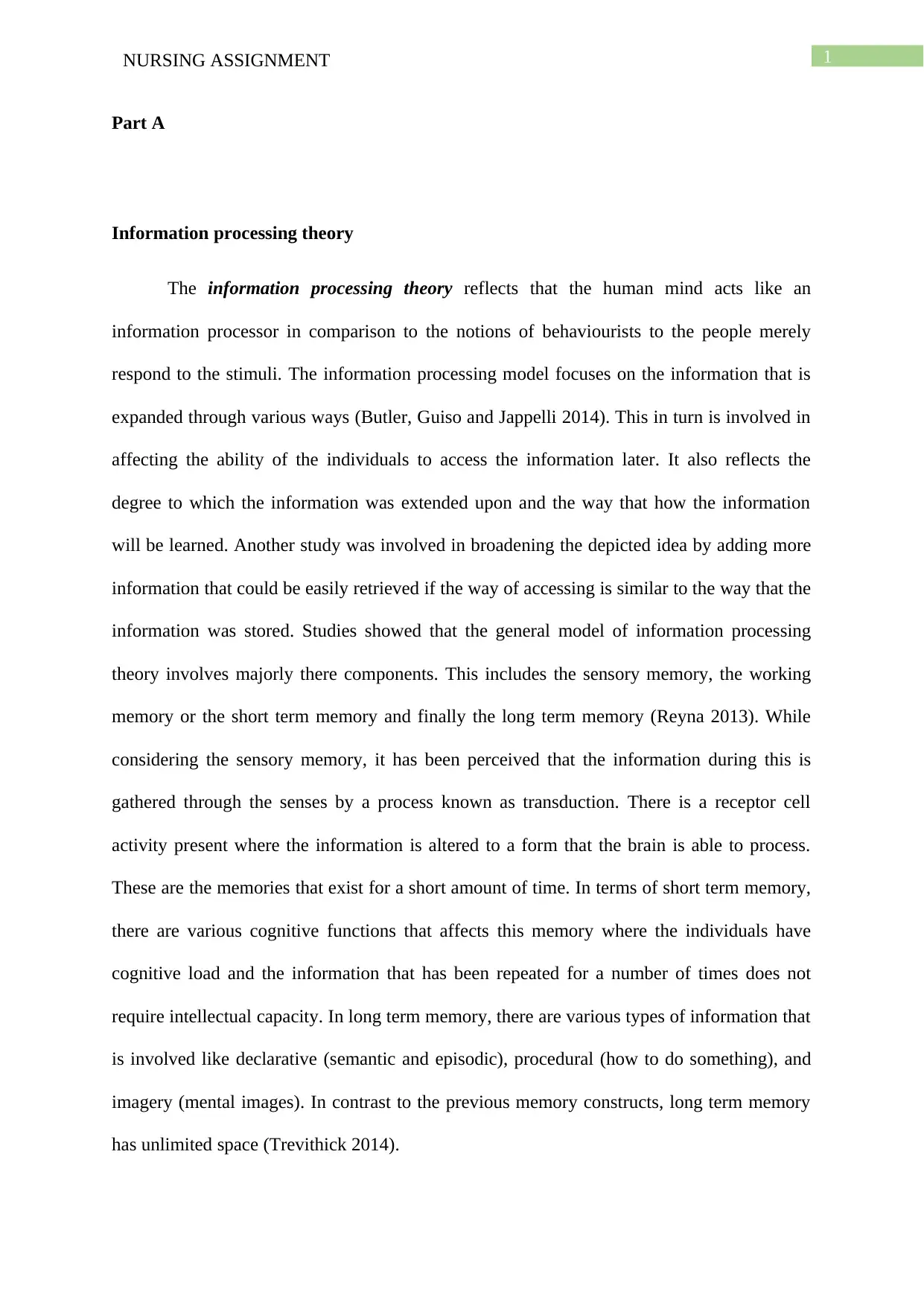
1NURSING ASSIGNMENT
Part A
Information processing theory
The information processing theory reflects that the human mind acts like an
information processor in comparison to the notions of behaviourists to the people merely
respond to the stimuli. The information processing model focuses on the information that is
expanded through various ways (Butler, Guiso and Jappelli 2014). This in turn is involved in
affecting the ability of the individuals to access the information later. It also reflects the
degree to which the information was extended upon and the way that how the information
will be learned. Another study was involved in broadening the depicted idea by adding more
information that could be easily retrieved if the way of accessing is similar to the way that the
information was stored. Studies showed that the general model of information processing
theory involves majorly there components. This includes the sensory memory, the working
memory or the short term memory and finally the long term memory (Reyna 2013). While
considering the sensory memory, it has been perceived that the information during this is
gathered through the senses by a process known as transduction. There is a receptor cell
activity present where the information is altered to a form that the brain is able to process.
These are the memories that exist for a short amount of time. In terms of short term memory,
there are various cognitive functions that affects this memory where the individuals have
cognitive load and the information that has been repeated for a number of times does not
require intellectual capacity. In long term memory, there are various types of information that
is involved like declarative (semantic and episodic), procedural (how to do something), and
imagery (mental images). In contrast to the previous memory constructs, long term memory
has unlimited space (Trevithick 2014).
Part A
Information processing theory
The information processing theory reflects that the human mind acts like an
information processor in comparison to the notions of behaviourists to the people merely
respond to the stimuli. The information processing model focuses on the information that is
expanded through various ways (Butler, Guiso and Jappelli 2014). This in turn is involved in
affecting the ability of the individuals to access the information later. It also reflects the
degree to which the information was extended upon and the way that how the information
will be learned. Another study was involved in broadening the depicted idea by adding more
information that could be easily retrieved if the way of accessing is similar to the way that the
information was stored. Studies showed that the general model of information processing
theory involves majorly there components. This includes the sensory memory, the working
memory or the short term memory and finally the long term memory (Reyna 2013). While
considering the sensory memory, it has been perceived that the information during this is
gathered through the senses by a process known as transduction. There is a receptor cell
activity present where the information is altered to a form that the brain is able to process.
These are the memories that exist for a short amount of time. In terms of short term memory,
there are various cognitive functions that affects this memory where the individuals have
cognitive load and the information that has been repeated for a number of times does not
require intellectual capacity. In long term memory, there are various types of information that
is involved like declarative (semantic and episodic), procedural (how to do something), and
imagery (mental images). In contrast to the previous memory constructs, long term memory
has unlimited space (Trevithick 2014).
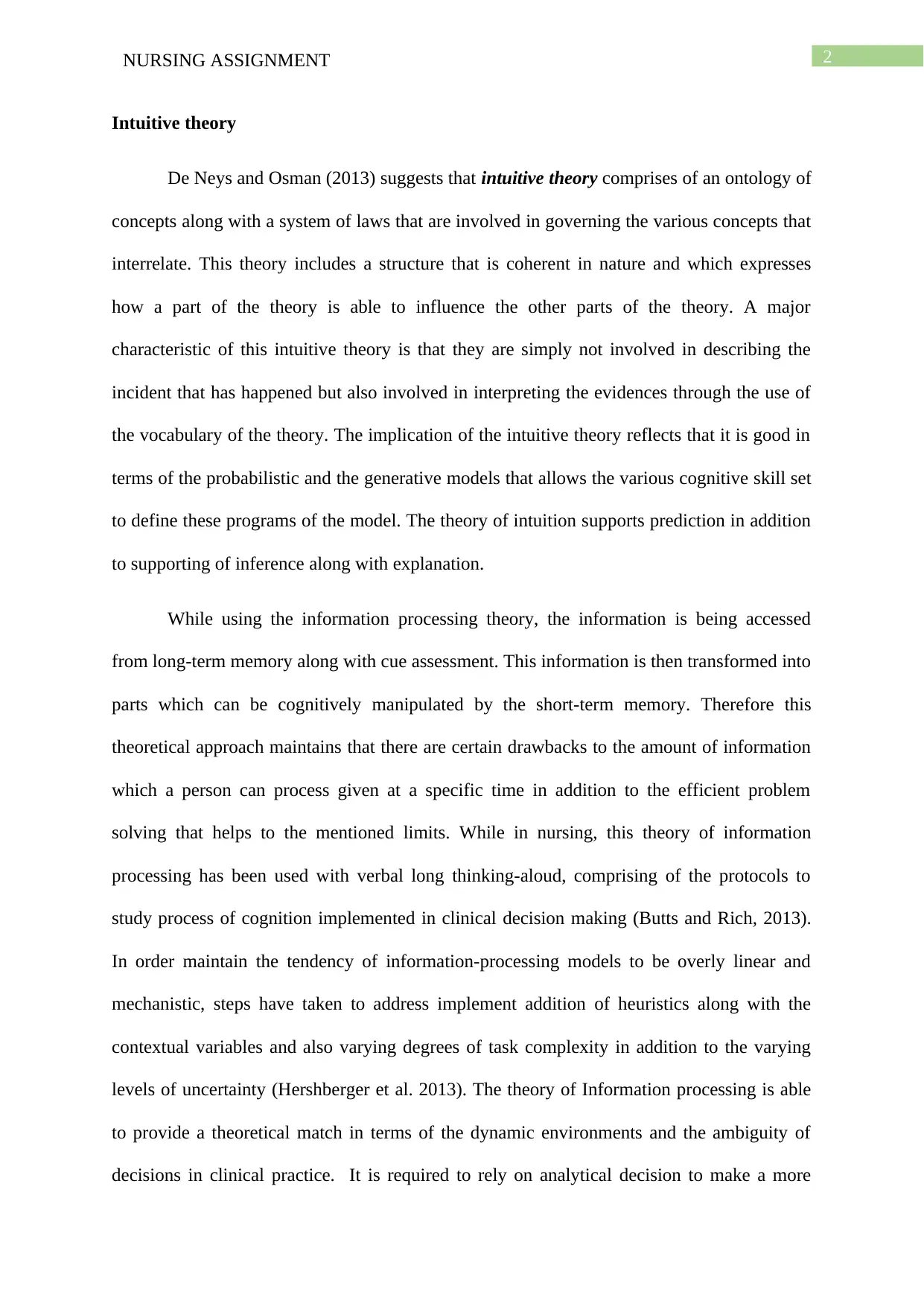
2NURSING ASSIGNMENT
Intuitive theory
De Neys and Osman (2013) suggests that intuitive theory comprises of an ontology of
concepts along with a system of laws that are involved in governing the various concepts that
interrelate. This theory includes a structure that is coherent in nature and which expresses
how a part of the theory is able to influence the other parts of the theory. A major
characteristic of this intuitive theory is that they are simply not involved in describing the
incident that has happened but also involved in interpreting the evidences through the use of
the vocabulary of the theory. The implication of the intuitive theory reflects that it is good in
terms of the probabilistic and the generative models that allows the various cognitive skill set
to define these programs of the model. The theory of intuition supports prediction in addition
to supporting of inference along with explanation.
While using the information processing theory, the information is being accessed
from long-term memory along with cue assessment. This information is then transformed into
parts which can be cognitively manipulated by the short-term memory. Therefore this
theoretical approach maintains that there are certain drawbacks to the amount of information
which a person can process given at a specific time in addition to the efficient problem
solving that helps to the mentioned limits. While in nursing, this theory of information
processing has been used with verbal long thinking-aloud, comprising of the protocols to
study process of cognition implemented in clinical decision making (Butts and Rich, 2013).
In order maintain the tendency of information-processing models to be overly linear and
mechanistic, steps have taken to address implement addition of heuristics along with the
contextual variables and also varying degrees of task complexity in addition to the varying
levels of uncertainty (Hershberger et al. 2013). The theory of Information processing is able
to provide a theoretical match in terms of the dynamic environments and the ambiguity of
decisions in clinical practice. It is required to rely on analytical decision to make a more
Intuitive theory
De Neys and Osman (2013) suggests that intuitive theory comprises of an ontology of
concepts along with a system of laws that are involved in governing the various concepts that
interrelate. This theory includes a structure that is coherent in nature and which expresses
how a part of the theory is able to influence the other parts of the theory. A major
characteristic of this intuitive theory is that they are simply not involved in describing the
incident that has happened but also involved in interpreting the evidences through the use of
the vocabulary of the theory. The implication of the intuitive theory reflects that it is good in
terms of the probabilistic and the generative models that allows the various cognitive skill set
to define these programs of the model. The theory of intuition supports prediction in addition
to supporting of inference along with explanation.
While using the information processing theory, the information is being accessed
from long-term memory along with cue assessment. This information is then transformed into
parts which can be cognitively manipulated by the short-term memory. Therefore this
theoretical approach maintains that there are certain drawbacks to the amount of information
which a person can process given at a specific time in addition to the efficient problem
solving that helps to the mentioned limits. While in nursing, this theory of information
processing has been used with verbal long thinking-aloud, comprising of the protocols to
study process of cognition implemented in clinical decision making (Butts and Rich, 2013).
In order maintain the tendency of information-processing models to be overly linear and
mechanistic, steps have taken to address implement addition of heuristics along with the
contextual variables and also varying degrees of task complexity in addition to the varying
levels of uncertainty (Hershberger et al. 2013). The theory of Information processing is able
to provide a theoretical match in terms of the dynamic environments and the ambiguity of
decisions in clinical practice. It is required to rely on analytical decision to make a more
⊘ This is a preview!⊘
Do you want full access?
Subscribe today to unlock all pages.

Trusted by 1+ million students worldwide
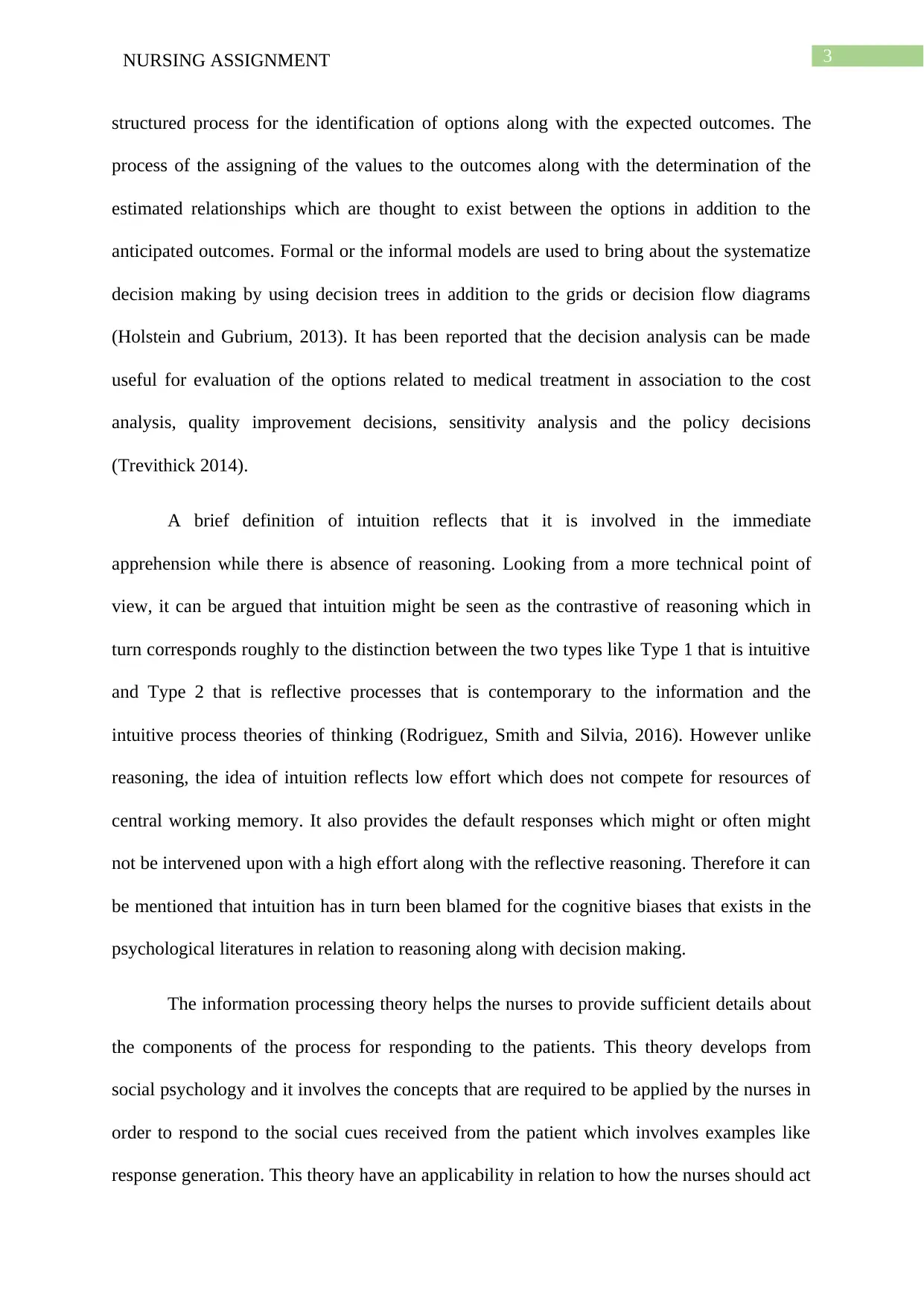
3NURSING ASSIGNMENT
structured process for the identification of options along with the expected outcomes. The
process of the assigning of the values to the outcomes along with the determination of the
estimated relationships which are thought to exist between the options in addition to the
anticipated outcomes. Formal or the informal models are used to bring about the systematize
decision making by using decision trees in addition to the grids or decision flow diagrams
(Holstein and Gubrium, 2013). It has been reported that the decision analysis can be made
useful for evaluation of the options related to medical treatment in association to the cost
analysis, quality improvement decisions, sensitivity analysis and the policy decisions
(Trevithick 2014).
A brief definition of intuition reflects that it is involved in the immediate
apprehension while there is absence of reasoning. Looking from a more technical point of
view, it can be argued that intuition might be seen as the contrastive of reasoning which in
turn corresponds roughly to the distinction between the two types like Type 1 that is intuitive
and Type 2 that is reflective processes that is contemporary to the information and the
intuitive process theories of thinking (Rodriguez, Smith and Silvia, 2016). However unlike
reasoning, the idea of intuition reflects low effort which does not compete for resources of
central working memory. It also provides the default responses which might or often might
not be intervened upon with a high effort along with the reflective reasoning. Therefore it can
be mentioned that intuition has in turn been blamed for the cognitive biases that exists in the
psychological literatures in relation to reasoning along with decision making.
The information processing theory helps the nurses to provide sufficient details about
the components of the process for responding to the patients. This theory develops from
social psychology and it involves the concepts that are required to be applied by the nurses in
order to respond to the social cues received from the patient which involves examples like
response generation. This theory have an applicability in relation to how the nurses should act
structured process for the identification of options along with the expected outcomes. The
process of the assigning of the values to the outcomes along with the determination of the
estimated relationships which are thought to exist between the options in addition to the
anticipated outcomes. Formal or the informal models are used to bring about the systematize
decision making by using decision trees in addition to the grids or decision flow diagrams
(Holstein and Gubrium, 2013). It has been reported that the decision analysis can be made
useful for evaluation of the options related to medical treatment in association to the cost
analysis, quality improvement decisions, sensitivity analysis and the policy decisions
(Trevithick 2014).
A brief definition of intuition reflects that it is involved in the immediate
apprehension while there is absence of reasoning. Looking from a more technical point of
view, it can be argued that intuition might be seen as the contrastive of reasoning which in
turn corresponds roughly to the distinction between the two types like Type 1 that is intuitive
and Type 2 that is reflective processes that is contemporary to the information and the
intuitive process theories of thinking (Rodriguez, Smith and Silvia, 2016). However unlike
reasoning, the idea of intuition reflects low effort which does not compete for resources of
central working memory. It also provides the default responses which might or often might
not be intervened upon with a high effort along with the reflective reasoning. Therefore it can
be mentioned that intuition has in turn been blamed for the cognitive biases that exists in the
psychological literatures in relation to reasoning along with decision making.
The information processing theory helps the nurses to provide sufficient details about
the components of the process for responding to the patients. This theory develops from
social psychology and it involves the concepts that are required to be applied by the nurses in
order to respond to the social cues received from the patient which involves examples like
response generation. This theory have an applicability in relation to how the nurses should act
Paraphrase This Document
Need a fresh take? Get an instant paraphrase of this document with our AI Paraphraser
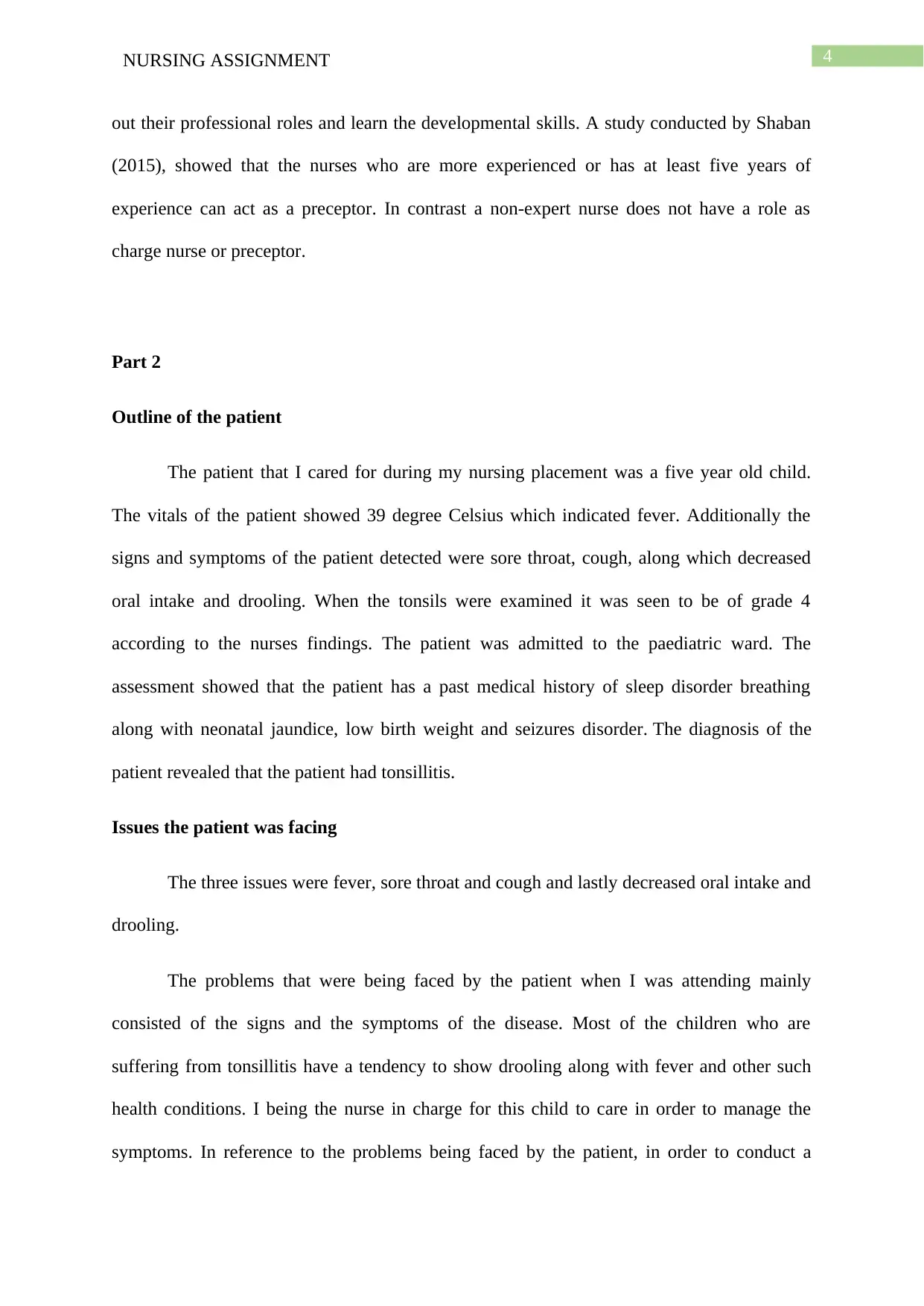
4NURSING ASSIGNMENT
out their professional roles and learn the developmental skills. A study conducted by Shaban
(2015), showed that the nurses who are more experienced or has at least five years of
experience can act as a preceptor. In contrast a non-expert nurse does not have a role as
charge nurse or preceptor.
Part 2
Outline of the patient
The patient that I cared for during my nursing placement was a five year old child.
The vitals of the patient showed 39 degree Celsius which indicated fever. Additionally the
signs and symptoms of the patient detected were sore throat, cough, along which decreased
oral intake and drooling. When the tonsils were examined it was seen to be of grade 4
according to the nurses findings. The patient was admitted to the paediatric ward. The
assessment showed that the patient has a past medical history of sleep disorder breathing
along with neonatal jaundice, low birth weight and seizures disorder. The diagnosis of the
patient revealed that the patient had tonsillitis.
Issues the patient was facing
The three issues were fever, sore throat and cough and lastly decreased oral intake and
drooling.
The problems that were being faced by the patient when I was attending mainly
consisted of the signs and the symptoms of the disease. Most of the children who are
suffering from tonsillitis have a tendency to show drooling along with fever and other such
health conditions. I being the nurse in charge for this child to care in order to manage the
symptoms. In reference to the problems being faced by the patient, in order to conduct a
out their professional roles and learn the developmental skills. A study conducted by Shaban
(2015), showed that the nurses who are more experienced or has at least five years of
experience can act as a preceptor. In contrast a non-expert nurse does not have a role as
charge nurse or preceptor.
Part 2
Outline of the patient
The patient that I cared for during my nursing placement was a five year old child.
The vitals of the patient showed 39 degree Celsius which indicated fever. Additionally the
signs and symptoms of the patient detected were sore throat, cough, along which decreased
oral intake and drooling. When the tonsils were examined it was seen to be of grade 4
according to the nurses findings. The patient was admitted to the paediatric ward. The
assessment showed that the patient has a past medical history of sleep disorder breathing
along with neonatal jaundice, low birth weight and seizures disorder. The diagnosis of the
patient revealed that the patient had tonsillitis.
Issues the patient was facing
The three issues were fever, sore throat and cough and lastly decreased oral intake and
drooling.
The problems that were being faced by the patient when I was attending mainly
consisted of the signs and the symptoms of the disease. Most of the children who are
suffering from tonsillitis have a tendency to show drooling along with fever and other such
health conditions. I being the nurse in charge for this child to care in order to manage the
symptoms. In reference to the problems being faced by the patient, in order to conduct a
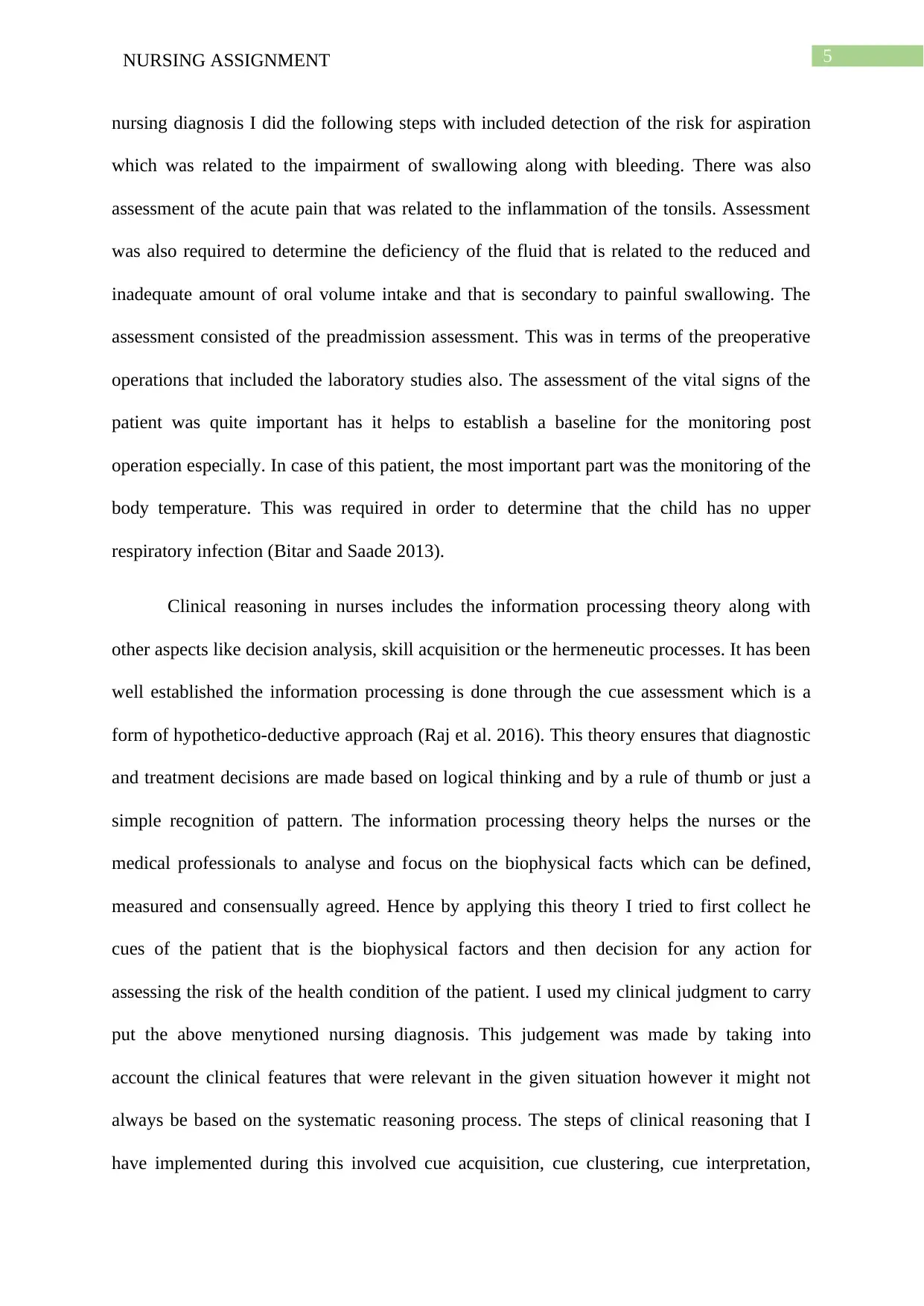
5NURSING ASSIGNMENT
nursing diagnosis I did the following steps with included detection of the risk for aspiration
which was related to the impairment of swallowing along with bleeding. There was also
assessment of the acute pain that was related to the inflammation of the tonsils. Assessment
was also required to determine the deficiency of the fluid that is related to the reduced and
inadequate amount of oral volume intake and that is secondary to painful swallowing. The
assessment consisted of the preadmission assessment. This was in terms of the preoperative
operations that included the laboratory studies also. The assessment of the vital signs of the
patient was quite important has it helps to establish a baseline for the monitoring post
operation especially. In case of this patient, the most important part was the monitoring of the
body temperature. This was required in order to determine that the child has no upper
respiratory infection (Bitar and Saade 2013).
Clinical reasoning in nurses includes the information processing theory along with
other aspects like decision analysis, skill acquisition or the hermeneutic processes. It has been
well established the information processing is done through the cue assessment which is a
form of hypothetico-deductive approach (Raj et al. 2016). This theory ensures that diagnostic
and treatment decisions are made based on logical thinking and by a rule of thumb or just a
simple recognition of pattern. The information processing theory helps the nurses or the
medical professionals to analyse and focus on the biophysical facts which can be defined,
measured and consensually agreed. Hence by applying this theory I tried to first collect he
cues of the patient that is the biophysical factors and then decision for any action for
assessing the risk of the health condition of the patient. I used my clinical judgment to carry
put the above menytioned nursing diagnosis. This judgement was made by taking into
account the clinical features that were relevant in the given situation however it might not
always be based on the systematic reasoning process. The steps of clinical reasoning that I
have implemented during this involved cue acquisition, cue clustering, cue interpretation,
nursing diagnosis I did the following steps with included detection of the risk for aspiration
which was related to the impairment of swallowing along with bleeding. There was also
assessment of the acute pain that was related to the inflammation of the tonsils. Assessment
was also required to determine the deficiency of the fluid that is related to the reduced and
inadequate amount of oral volume intake and that is secondary to painful swallowing. The
assessment consisted of the preadmission assessment. This was in terms of the preoperative
operations that included the laboratory studies also. The assessment of the vital signs of the
patient was quite important has it helps to establish a baseline for the monitoring post
operation especially. In case of this patient, the most important part was the monitoring of the
body temperature. This was required in order to determine that the child has no upper
respiratory infection (Bitar and Saade 2013).
Clinical reasoning in nurses includes the information processing theory along with
other aspects like decision analysis, skill acquisition or the hermeneutic processes. It has been
well established the information processing is done through the cue assessment which is a
form of hypothetico-deductive approach (Raj et al. 2016). This theory ensures that diagnostic
and treatment decisions are made based on logical thinking and by a rule of thumb or just a
simple recognition of pattern. The information processing theory helps the nurses or the
medical professionals to analyse and focus on the biophysical facts which can be defined,
measured and consensually agreed. Hence by applying this theory I tried to first collect he
cues of the patient that is the biophysical factors and then decision for any action for
assessing the risk of the health condition of the patient. I used my clinical judgment to carry
put the above menytioned nursing diagnosis. This judgement was made by taking into
account the clinical features that were relevant in the given situation however it might not
always be based on the systematic reasoning process. The steps of clinical reasoning that I
have implemented during this involved cue acquisition, cue clustering, cue interpretation,
⊘ This is a preview!⊘
Do you want full access?
Subscribe today to unlock all pages.

Trusted by 1+ million students worldwide
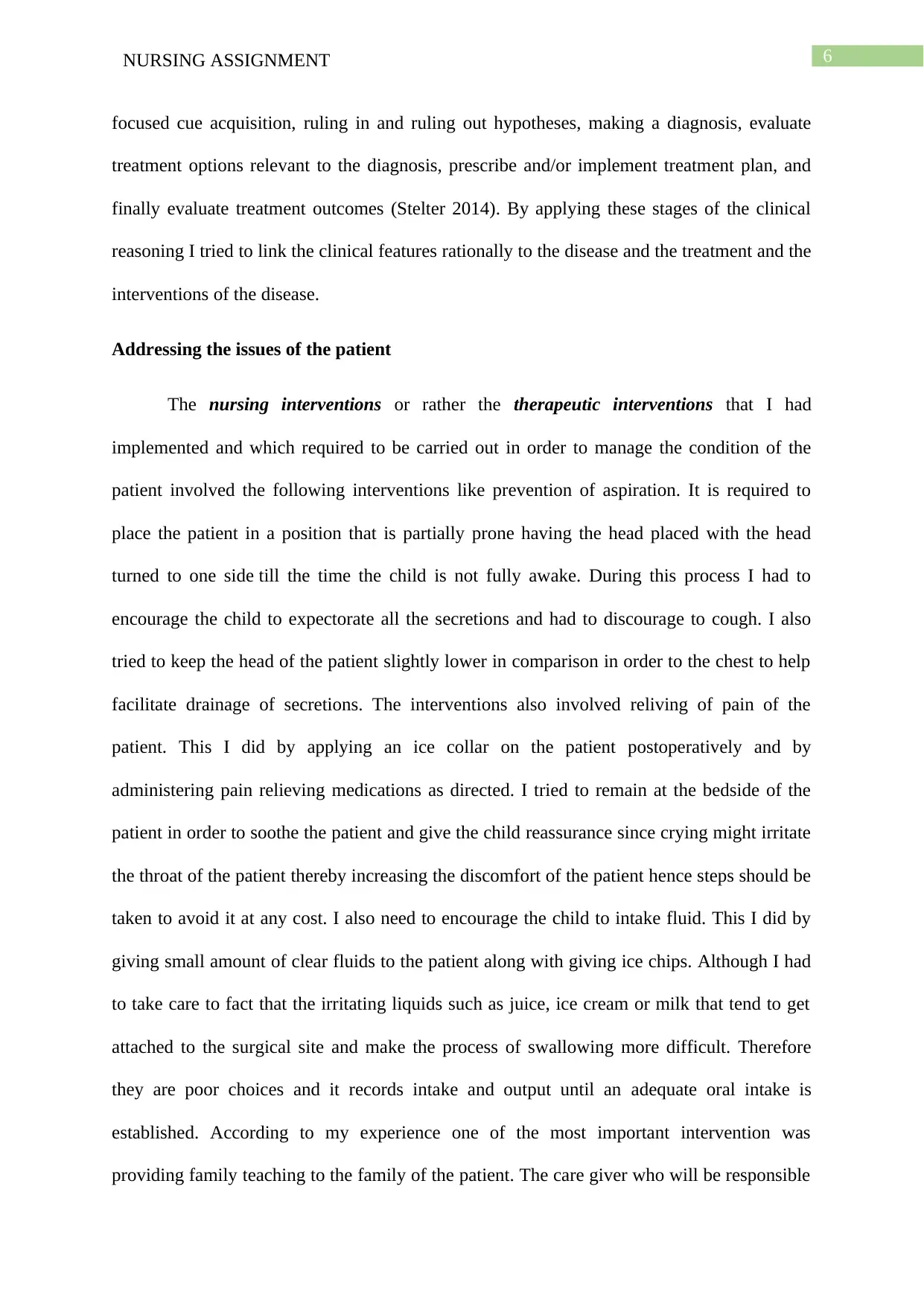
6NURSING ASSIGNMENT
focused cue acquisition, ruling in and ruling out hypotheses, making a diagnosis, evaluate
treatment options relevant to the diagnosis, prescribe and/or implement treatment plan, and
finally evaluate treatment outcomes (Stelter 2014). By applying these stages of the clinical
reasoning I tried to link the clinical features rationally to the disease and the treatment and the
interventions of the disease.
Addressing the issues of the patient
The nursing interventions or rather the therapeutic interventions that I had
implemented and which required to be carried out in order to manage the condition of the
patient involved the following interventions like prevention of aspiration. It is required to
place the patient in a position that is partially prone having the head placed with the head
turned to one side till the time the child is not fully awake. During this process I had to
encourage the child to expectorate all the secretions and had to discourage to cough. I also
tried to keep the head of the patient slightly lower in comparison in order to the chest to help
facilitate drainage of secretions. The interventions also involved reliving of pain of the
patient. This I did by applying an ice collar on the patient postoperatively and by
administering pain relieving medications as directed. I tried to remain at the bedside of the
patient in order to soothe the patient and give the child reassurance since crying might irritate
the throat of the patient thereby increasing the discomfort of the patient hence steps should be
taken to avoid it at any cost. I also need to encourage the child to intake fluid. This I did by
giving small amount of clear fluids to the patient along with giving ice chips. Although I had
to take care to fact that the irritating liquids such as juice, ice cream or milk that tend to get
attached to the surgical site and make the process of swallowing more difficult. Therefore
they are poor choices and it records intake and output until an adequate oral intake is
established. According to my experience one of the most important intervention was
providing family teaching to the family of the patient. The care giver who will be responsible
focused cue acquisition, ruling in and ruling out hypotheses, making a diagnosis, evaluate
treatment options relevant to the diagnosis, prescribe and/or implement treatment plan, and
finally evaluate treatment outcomes (Stelter 2014). By applying these stages of the clinical
reasoning I tried to link the clinical features rationally to the disease and the treatment and the
interventions of the disease.
Addressing the issues of the patient
The nursing interventions or rather the therapeutic interventions that I had
implemented and which required to be carried out in order to manage the condition of the
patient involved the following interventions like prevention of aspiration. It is required to
place the patient in a position that is partially prone having the head placed with the head
turned to one side till the time the child is not fully awake. During this process I had to
encourage the child to expectorate all the secretions and had to discourage to cough. I also
tried to keep the head of the patient slightly lower in comparison in order to the chest to help
facilitate drainage of secretions. The interventions also involved reliving of pain of the
patient. This I did by applying an ice collar on the patient postoperatively and by
administering pain relieving medications as directed. I tried to remain at the bedside of the
patient in order to soothe the patient and give the child reassurance since crying might irritate
the throat of the patient thereby increasing the discomfort of the patient hence steps should be
taken to avoid it at any cost. I also need to encourage the child to intake fluid. This I did by
giving small amount of clear fluids to the patient along with giving ice chips. Although I had
to take care to fact that the irritating liquids such as juice, ice cream or milk that tend to get
attached to the surgical site and make the process of swallowing more difficult. Therefore
they are poor choices and it records intake and output until an adequate oral intake is
established. According to my experience one of the most important intervention was
providing family teaching to the family of the patient. The care giver who will be responsible
Paraphrase This Document
Need a fresh take? Get an instant paraphrase of this document with our AI Paraphraser
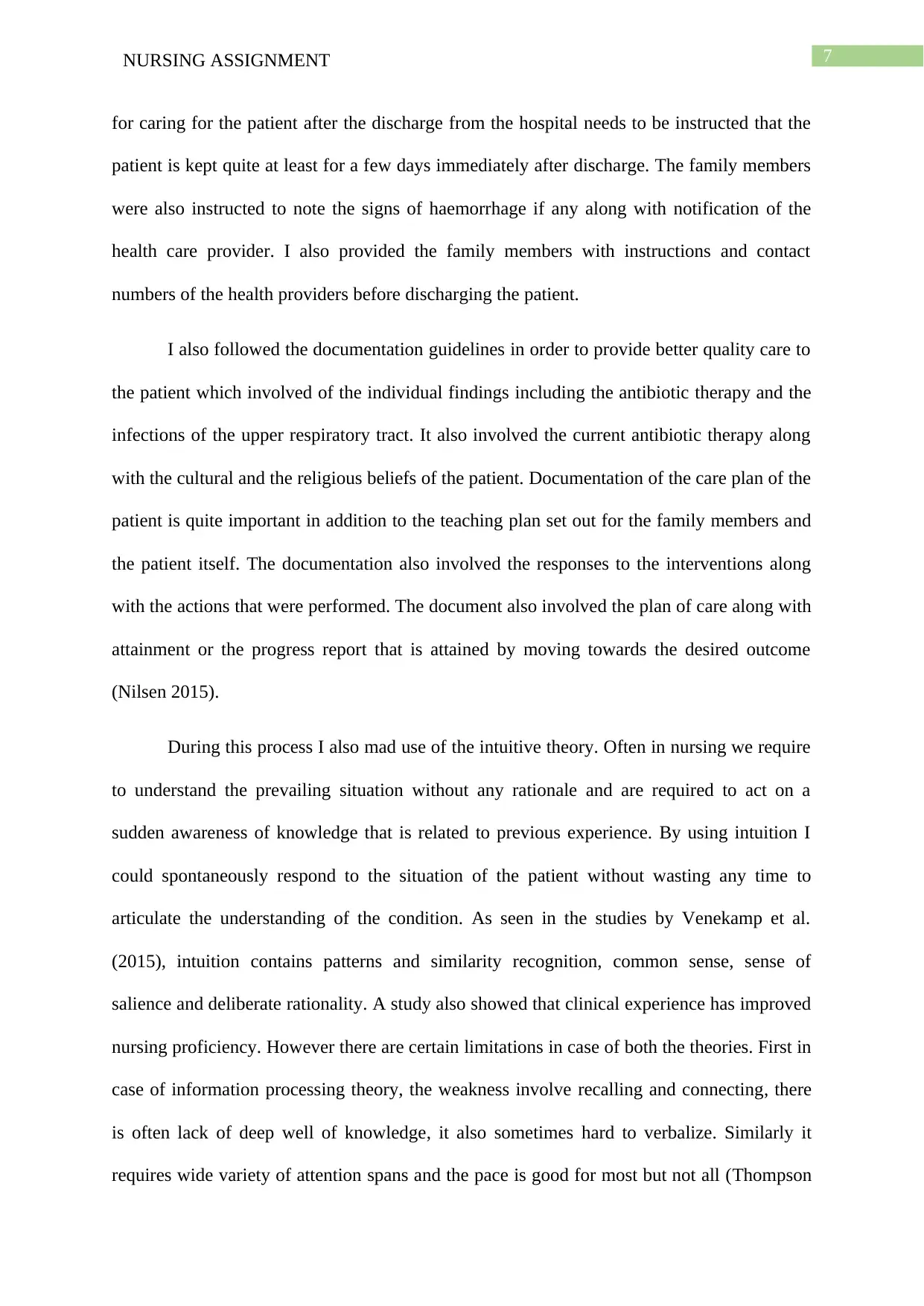
7NURSING ASSIGNMENT
for caring for the patient after the discharge from the hospital needs to be instructed that the
patient is kept quite at least for a few days immediately after discharge. The family members
were also instructed to note the signs of haemorrhage if any along with notification of the
health care provider. I also provided the family members with instructions and contact
numbers of the health providers before discharging the patient.
I also followed the documentation guidelines in order to provide better quality care to
the patient which involved of the individual findings including the antibiotic therapy and the
infections of the upper respiratory tract. It also involved the current antibiotic therapy along
with the cultural and the religious beliefs of the patient. Documentation of the care plan of the
patient is quite important in addition to the teaching plan set out for the family members and
the patient itself. The documentation also involved the responses to the interventions along
with the actions that were performed. The document also involved the plan of care along with
attainment or the progress report that is attained by moving towards the desired outcome
(Nilsen 2015).
During this process I also mad use of the intuitive theory. Often in nursing we require
to understand the prevailing situation without any rationale and are required to act on a
sudden awareness of knowledge that is related to previous experience. By using intuition I
could spontaneously respond to the situation of the patient without wasting any time to
articulate the understanding of the condition. As seen in the studies by Venekamp et al.
(2015), intuition contains patterns and similarity recognition, common sense, sense of
salience and deliberate rationality. A study also showed that clinical experience has improved
nursing proficiency. However there are certain limitations in case of both the theories. First in
case of information processing theory, the weakness involve recalling and connecting, there
is often lack of deep well of knowledge, it also sometimes hard to verbalize. Similarly it
requires wide variety of attention spans and the pace is good for most but not all (Thompson
for caring for the patient after the discharge from the hospital needs to be instructed that the
patient is kept quite at least for a few days immediately after discharge. The family members
were also instructed to note the signs of haemorrhage if any along with notification of the
health care provider. I also provided the family members with instructions and contact
numbers of the health providers before discharging the patient.
I also followed the documentation guidelines in order to provide better quality care to
the patient which involved of the individual findings including the antibiotic therapy and the
infections of the upper respiratory tract. It also involved the current antibiotic therapy along
with the cultural and the religious beliefs of the patient. Documentation of the care plan of the
patient is quite important in addition to the teaching plan set out for the family members and
the patient itself. The documentation also involved the responses to the interventions along
with the actions that were performed. The document also involved the plan of care along with
attainment or the progress report that is attained by moving towards the desired outcome
(Nilsen 2015).
During this process I also mad use of the intuitive theory. Often in nursing we require
to understand the prevailing situation without any rationale and are required to act on a
sudden awareness of knowledge that is related to previous experience. By using intuition I
could spontaneously respond to the situation of the patient without wasting any time to
articulate the understanding of the condition. As seen in the studies by Venekamp et al.
(2015), intuition contains patterns and similarity recognition, common sense, sense of
salience and deliberate rationality. A study also showed that clinical experience has improved
nursing proficiency. However there are certain limitations in case of both the theories. First in
case of information processing theory, the weakness involve recalling and connecting, there
is often lack of deep well of knowledge, it also sometimes hard to verbalize. Similarly it
requires wide variety of attention spans and the pace is good for most but not all (Thompson
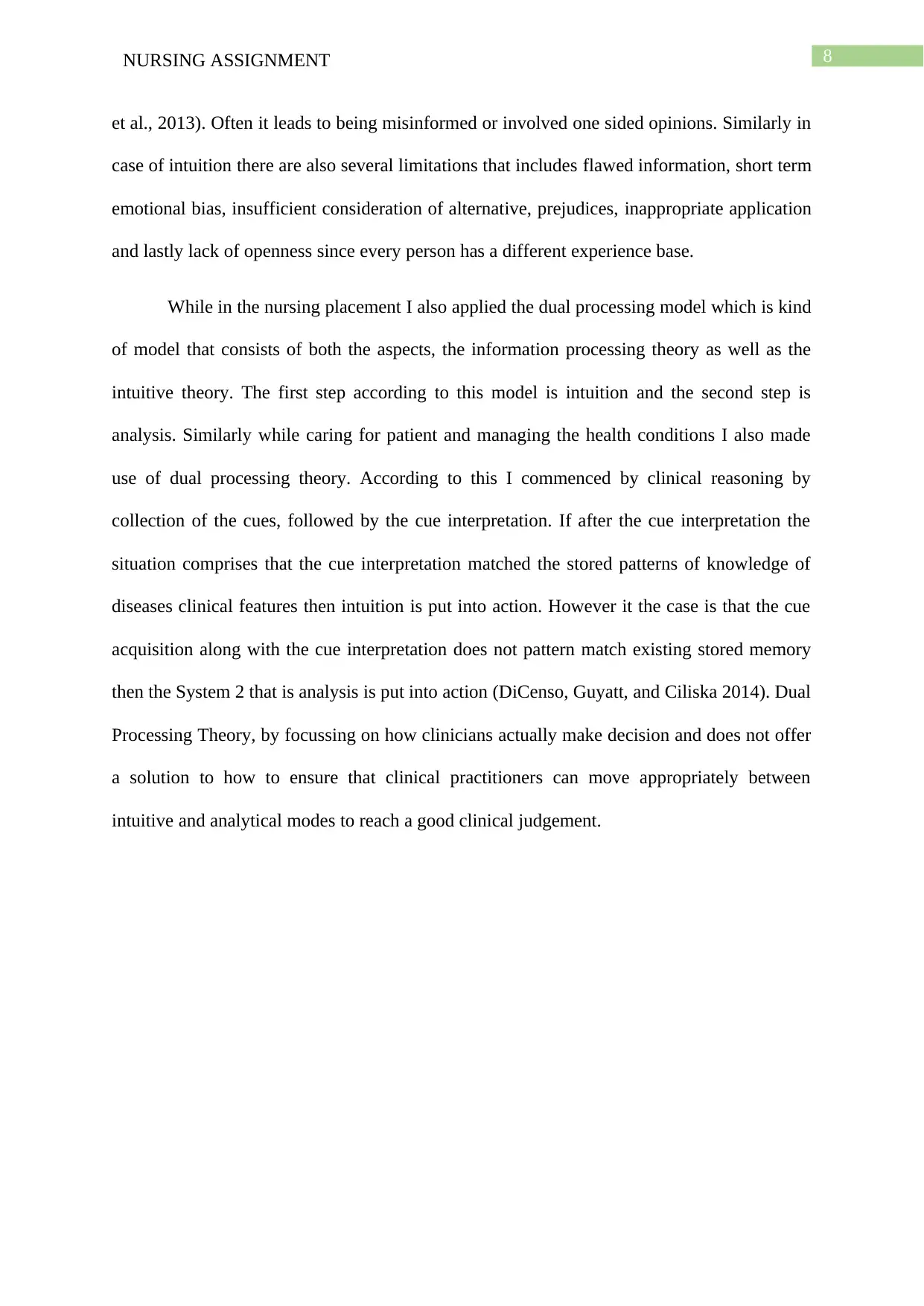
8NURSING ASSIGNMENT
et al., 2013). Often it leads to being misinformed or involved one sided opinions. Similarly in
case of intuition there are also several limitations that includes flawed information, short term
emotional bias, insufficient consideration of alternative, prejudices, inappropriate application
and lastly lack of openness since every person has a different experience base.
While in the nursing placement I also applied the dual processing model which is kind
of model that consists of both the aspects, the information processing theory as well as the
intuitive theory. The first step according to this model is intuition and the second step is
analysis. Similarly while caring for patient and managing the health conditions I also made
use of dual processing theory. According to this I commenced by clinical reasoning by
collection of the cues, followed by the cue interpretation. If after the cue interpretation the
situation comprises that the cue interpretation matched the stored patterns of knowledge of
diseases clinical features then intuition is put into action. However it the case is that the cue
acquisition along with the cue interpretation does not pattern match existing stored memory
then the System 2 that is analysis is put into action (DiCenso, Guyatt, and Ciliska 2014). Dual
Processing Theory, by focussing on how clinicians actually make decision and does not offer
a solution to how to ensure that clinical practitioners can move appropriately between
intuitive and analytical modes to reach a good clinical judgement.
et al., 2013). Often it leads to being misinformed or involved one sided opinions. Similarly in
case of intuition there are also several limitations that includes flawed information, short term
emotional bias, insufficient consideration of alternative, prejudices, inappropriate application
and lastly lack of openness since every person has a different experience base.
While in the nursing placement I also applied the dual processing model which is kind
of model that consists of both the aspects, the information processing theory as well as the
intuitive theory. The first step according to this model is intuition and the second step is
analysis. Similarly while caring for patient and managing the health conditions I also made
use of dual processing theory. According to this I commenced by clinical reasoning by
collection of the cues, followed by the cue interpretation. If after the cue interpretation the
situation comprises that the cue interpretation matched the stored patterns of knowledge of
diseases clinical features then intuition is put into action. However it the case is that the cue
acquisition along with the cue interpretation does not pattern match existing stored memory
then the System 2 that is analysis is put into action (DiCenso, Guyatt, and Ciliska 2014). Dual
Processing Theory, by focussing on how clinicians actually make decision and does not offer
a solution to how to ensure that clinical practitioners can move appropriately between
intuitive and analytical modes to reach a good clinical judgement.
⊘ This is a preview!⊘
Do you want full access?
Subscribe today to unlock all pages.

Trusted by 1+ million students worldwide
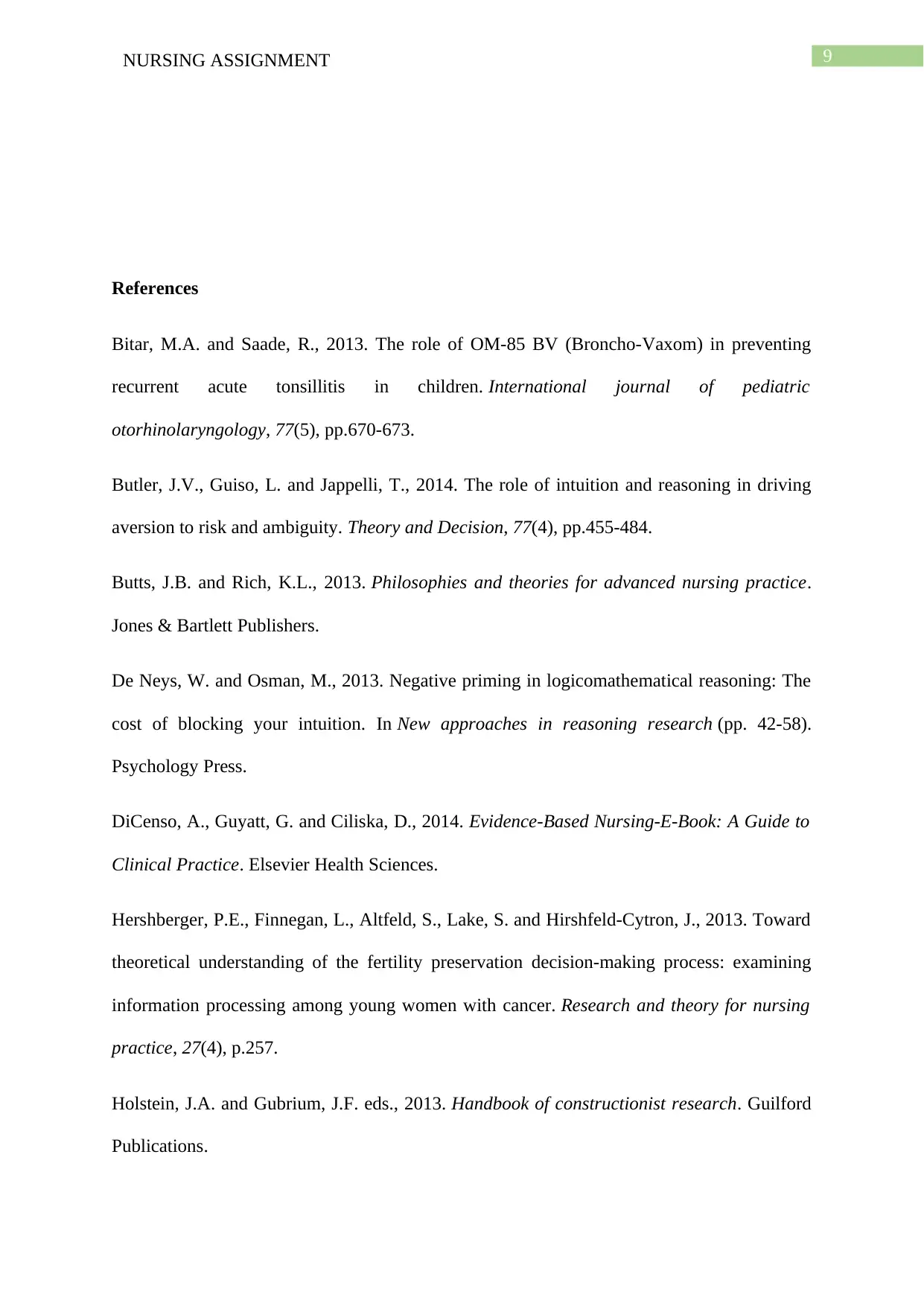
9NURSING ASSIGNMENT
References
Bitar, M.A. and Saade, R., 2013. The role of OM-85 BV (Broncho-Vaxom) in preventing
recurrent acute tonsillitis in children. International journal of pediatric
otorhinolaryngology, 77(5), pp.670-673.
Butler, J.V., Guiso, L. and Jappelli, T., 2014. The role of intuition and reasoning in driving
aversion to risk and ambiguity. Theory and Decision, 77(4), pp.455-484.
Butts, J.B. and Rich, K.L., 2013. Philosophies and theories for advanced nursing practice.
Jones & Bartlett Publishers.
De Neys, W. and Osman, M., 2013. Negative priming in logicomathematical reasoning: The
cost of blocking your intuition. In New approaches in reasoning research (pp. 42-58).
Psychology Press.
DiCenso, A., Guyatt, G. and Ciliska, D., 2014. Evidence-Based Nursing-E-Book: A Guide to
Clinical Practice. Elsevier Health Sciences.
Hershberger, P.E., Finnegan, L., Altfeld, S., Lake, S. and Hirshfeld-Cytron, J., 2013. Toward
theoretical understanding of the fertility preservation decision-making process: examining
information processing among young women with cancer. Research and theory for nursing
practice, 27(4), p.257.
Holstein, J.A. and Gubrium, J.F. eds., 2013. Handbook of constructionist research. Guilford
Publications.
References
Bitar, M.A. and Saade, R., 2013. The role of OM-85 BV (Broncho-Vaxom) in preventing
recurrent acute tonsillitis in children. International journal of pediatric
otorhinolaryngology, 77(5), pp.670-673.
Butler, J.V., Guiso, L. and Jappelli, T., 2014. The role of intuition and reasoning in driving
aversion to risk and ambiguity. Theory and Decision, 77(4), pp.455-484.
Butts, J.B. and Rich, K.L., 2013. Philosophies and theories for advanced nursing practice.
Jones & Bartlett Publishers.
De Neys, W. and Osman, M., 2013. Negative priming in logicomathematical reasoning: The
cost of blocking your intuition. In New approaches in reasoning research (pp. 42-58).
Psychology Press.
DiCenso, A., Guyatt, G. and Ciliska, D., 2014. Evidence-Based Nursing-E-Book: A Guide to
Clinical Practice. Elsevier Health Sciences.
Hershberger, P.E., Finnegan, L., Altfeld, S., Lake, S. and Hirshfeld-Cytron, J., 2013. Toward
theoretical understanding of the fertility preservation decision-making process: examining
information processing among young women with cancer. Research and theory for nursing
practice, 27(4), p.257.
Holstein, J.A. and Gubrium, J.F. eds., 2013. Handbook of constructionist research. Guilford
Publications.
Paraphrase This Document
Need a fresh take? Get an instant paraphrase of this document with our AI Paraphraser
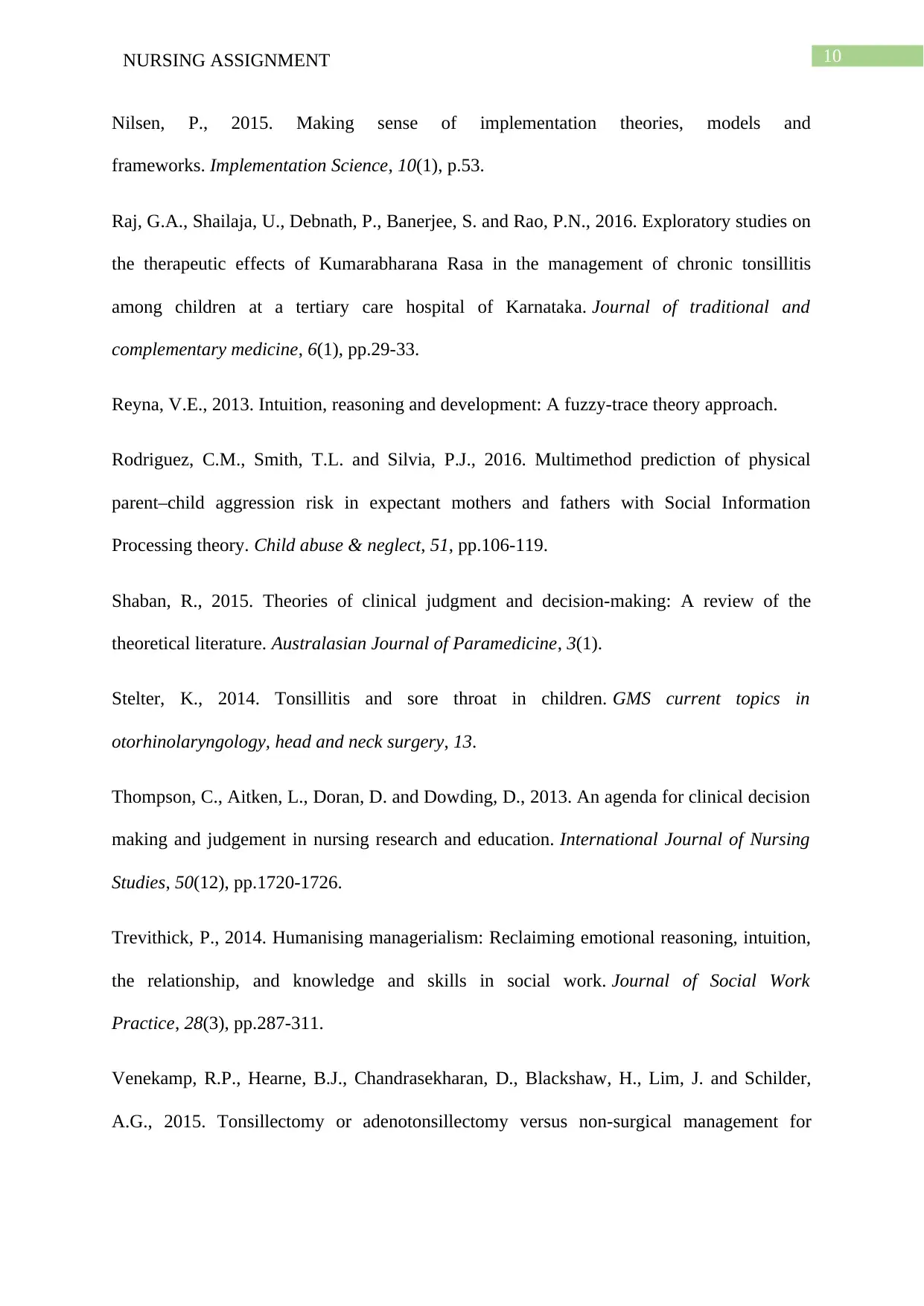
10NURSING ASSIGNMENT
Nilsen, P., 2015. Making sense of implementation theories, models and
frameworks. Implementation Science, 10(1), p.53.
Raj, G.A., Shailaja, U., Debnath, P., Banerjee, S. and Rao, P.N., 2016. Exploratory studies on
the therapeutic effects of Kumarabharana Rasa in the management of chronic tonsillitis
among children at a tertiary care hospital of Karnataka. Journal of traditional and
complementary medicine, 6(1), pp.29-33.
Reyna, V.E., 2013. Intuition, reasoning and development: A fuzzy-trace theory approach.
Rodriguez, C.M., Smith, T.L. and Silvia, P.J., 2016. Multimethod prediction of physical
parent–child aggression risk in expectant mothers and fathers with Social Information
Processing theory. Child abuse & neglect, 51, pp.106-119.
Shaban, R., 2015. Theories of clinical judgment and decision-making: A review of the
theoretical literature. Australasian Journal of Paramedicine, 3(1).
Stelter, K., 2014. Tonsillitis and sore throat in children. GMS current topics in
otorhinolaryngology, head and neck surgery, 13.
Thompson, C., Aitken, L., Doran, D. and Dowding, D., 2013. An agenda for clinical decision
making and judgement in nursing research and education. International Journal of Nursing
Studies, 50(12), pp.1720-1726.
Trevithick, P., 2014. Humanising managerialism: Reclaiming emotional reasoning, intuition,
the relationship, and knowledge and skills in social work. Journal of Social Work
Practice, 28(3), pp.287-311.
Venekamp, R.P., Hearne, B.J., Chandrasekharan, D., Blackshaw, H., Lim, J. and Schilder,
A.G., 2015. Tonsillectomy or adenotonsillectomy versus non-surgical management for
Nilsen, P., 2015. Making sense of implementation theories, models and
frameworks. Implementation Science, 10(1), p.53.
Raj, G.A., Shailaja, U., Debnath, P., Banerjee, S. and Rao, P.N., 2016. Exploratory studies on
the therapeutic effects of Kumarabharana Rasa in the management of chronic tonsillitis
among children at a tertiary care hospital of Karnataka. Journal of traditional and
complementary medicine, 6(1), pp.29-33.
Reyna, V.E., 2013. Intuition, reasoning and development: A fuzzy-trace theory approach.
Rodriguez, C.M., Smith, T.L. and Silvia, P.J., 2016. Multimethod prediction of physical
parent–child aggression risk in expectant mothers and fathers with Social Information
Processing theory. Child abuse & neglect, 51, pp.106-119.
Shaban, R., 2015. Theories of clinical judgment and decision-making: A review of the
theoretical literature. Australasian Journal of Paramedicine, 3(1).
Stelter, K., 2014. Tonsillitis and sore throat in children. GMS current topics in
otorhinolaryngology, head and neck surgery, 13.
Thompson, C., Aitken, L., Doran, D. and Dowding, D., 2013. An agenda for clinical decision
making and judgement in nursing research and education. International Journal of Nursing
Studies, 50(12), pp.1720-1726.
Trevithick, P., 2014. Humanising managerialism: Reclaiming emotional reasoning, intuition,
the relationship, and knowledge and skills in social work. Journal of Social Work
Practice, 28(3), pp.287-311.
Venekamp, R.P., Hearne, B.J., Chandrasekharan, D., Blackshaw, H., Lim, J. and Schilder,
A.G., 2015. Tonsillectomy or adenotonsillectomy versus non-surgical management for

11NURSING ASSIGNMENT
obstructive sleep-disordered breathing in children. Cochrane Database of Systematic
Reviews, 2015(10).
obstructive sleep-disordered breathing in children. Cochrane Database of Systematic
Reviews, 2015(10).
⊘ This is a preview!⊘
Do you want full access?
Subscribe today to unlock all pages.

Trusted by 1+ million students worldwide
1 out of 12
Related Documents
Your All-in-One AI-Powered Toolkit for Academic Success.
+13062052269
info@desklib.com
Available 24*7 on WhatsApp / Email
![[object Object]](/_next/static/media/star-bottom.7253800d.svg)
Unlock your academic potential
Copyright © 2020–2025 A2Z Services. All Rights Reserved. Developed and managed by ZUCOL.





